HP EliteBook 8740w: IPS on the Go
by Dustin Sklavos on December 8, 2010 3:10 AM EST- Posted in
- Laptops
- IT Computing
- Intel
- HP
- EliteBook
- Mobile Workstation
- Quadro
- NVIDIA
Futuremark and Gaming
Since NVIDIA's Quadro 5000M is the fastest mobile workstation GPU they offer, we figured it would be only fair to put it through its paces in our "High" and "Ultra" presets. Again it's going to face off against some of the desktop systems we've tested to give you some idea of the performance difference, but it's also important to remember that this chip is tuned for OpenGL and workstation-class workloads, not gaming.
We'll start with Futuremark, just to get it out of the way.
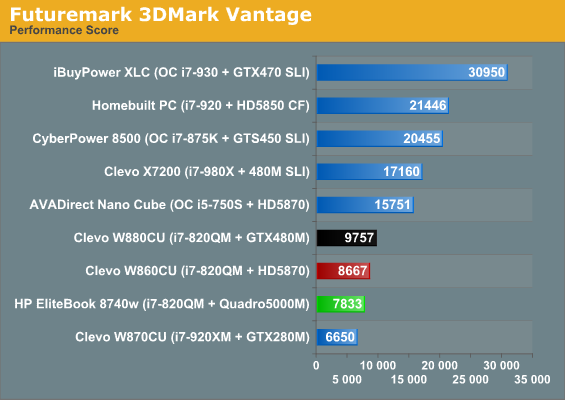
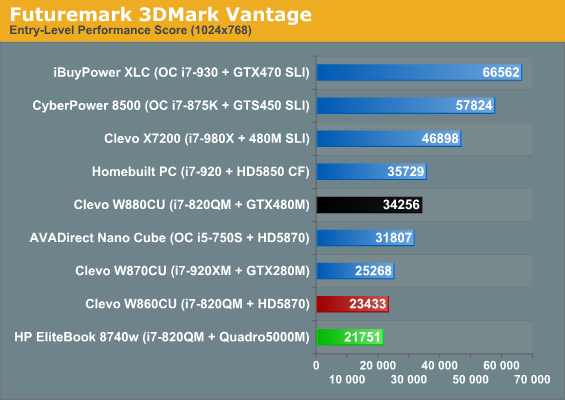
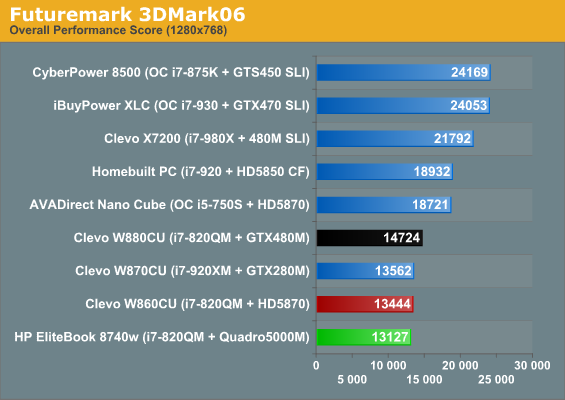
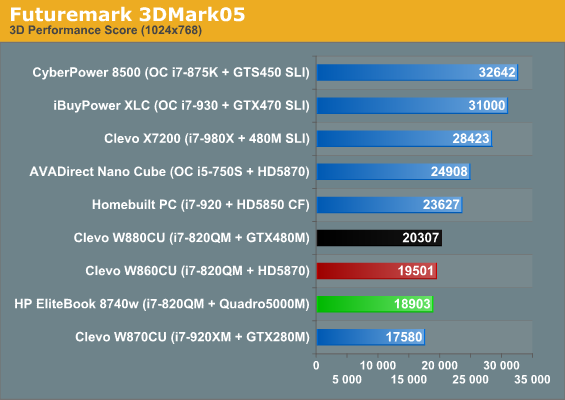
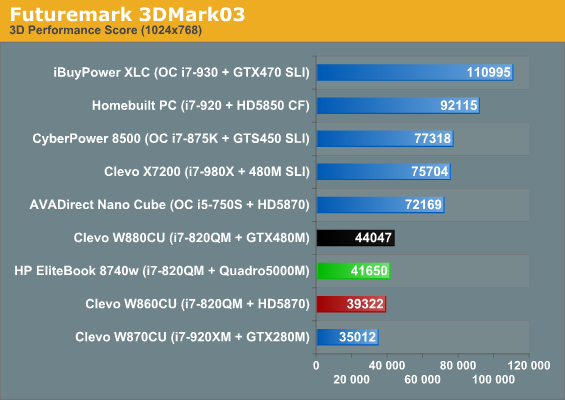
Futuremark performance isn't too impressive, with the GTX 480M posting a comfortable lead over its OpenGL-optimized sibling. Let's see what happens when we move to gaming in our "High" preset, though.
At this point it's worth mentioning that though the EliteBook's screen runs at a (very attractive) 1920x1200 native resolution, we've stuck with our 16:9 benchmark resolutions. The performance difference between 1080p and 1920x1200 is slight, and doing so helps us keep results consistent with the other notebooks we test.
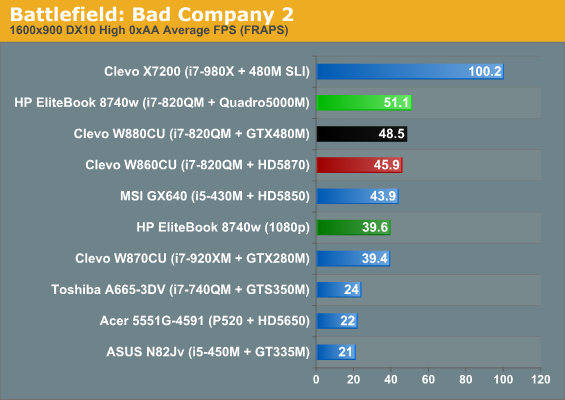
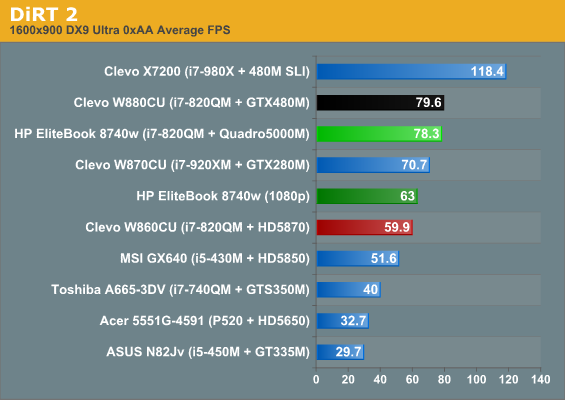
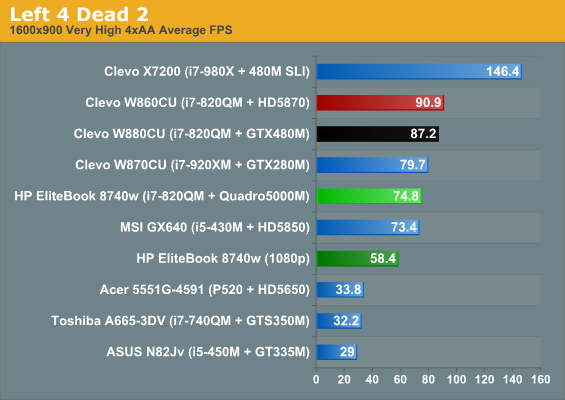
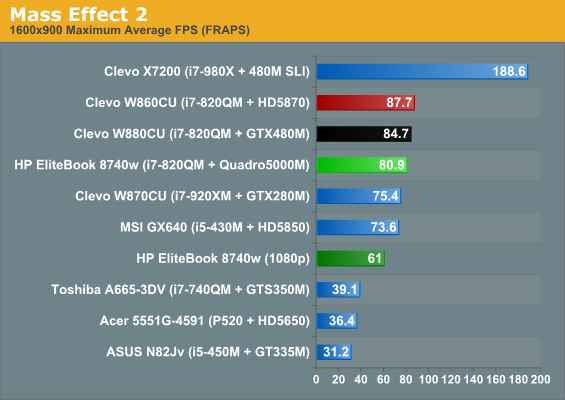
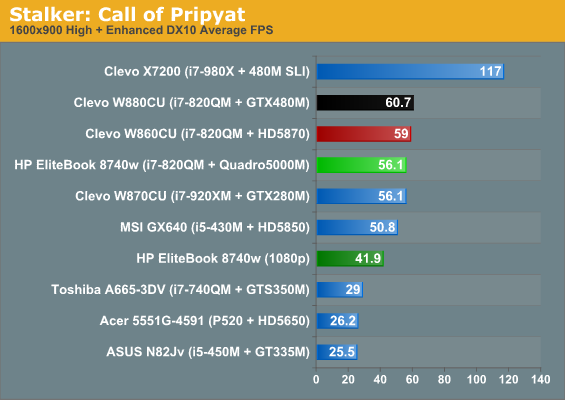
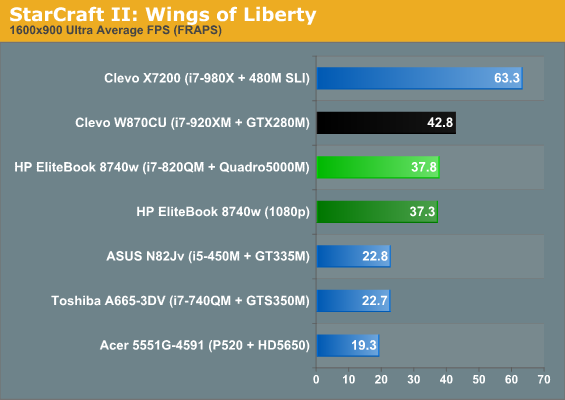
First, the great news: even at our "High" preset the 5000M in the EliteBook is able to post consistently playable numbers at 1080p with more than enough room to breathe. It trades blows with both the GeForce GTX 480M and ATI's Mobility Radeon HD 5870—not too shabby. But let's see what happens when we really max things out.
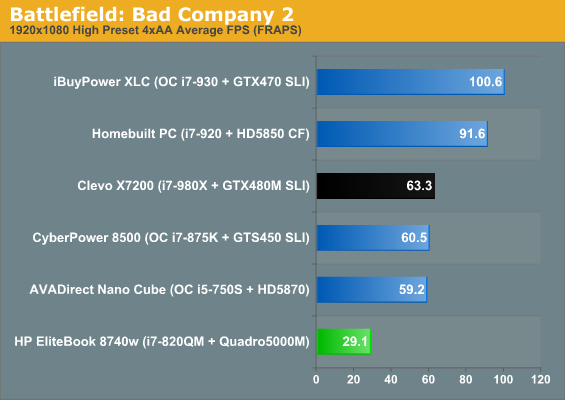


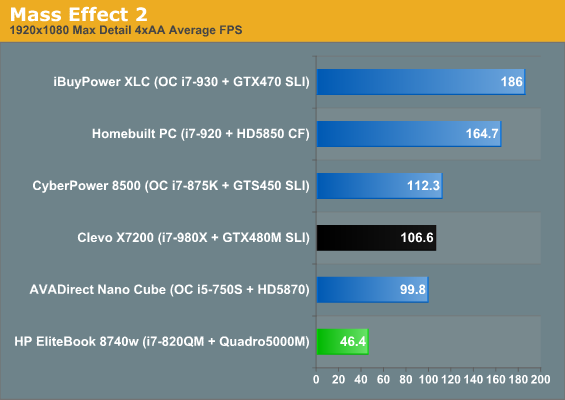
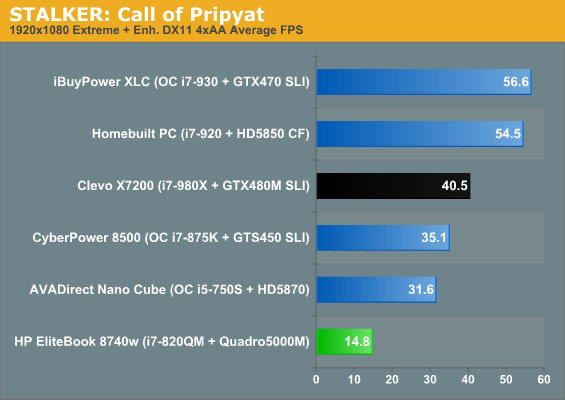
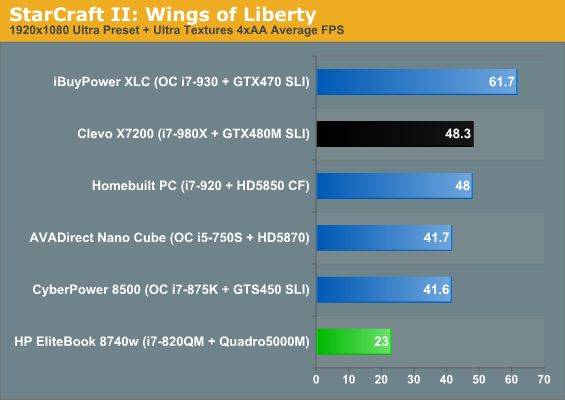
Unfortunately it's at these ultra settings that the 5000M really starts to struggle, and it's here we see the massive gulf in performance between desktop and mobile graphics. While the 5000M is still going to be able to game like a champ (when you're not working, naturally), we still can't help but wonder why NVIDIA's engineers aren't using the far more efficient GF104 chip the GeForce GTX 460 is based on for their mobile high end. AMD isn't doing itself any favors either; the Mobility Radeon HD 5870 was an incremental upgrade on last generation's mobile top end, and they now have the more efficient Barts GPU to build a halfway decent mobile graphics part out of.
The 5000M is fast, but just as we said about its consumer counterpart, the GTX 480M, it just doesn't actually make any sense to cram a horribly truncated GF100 into a laptop. Bring on GF104 or GF110 already.










63 Comments
View All Comments
erple2 - Friday, December 10, 2010 - link
That 1000 dollars more or less covers the upgrade from the FX3800M to the FX5000M. So I'd be willing to bet that's where the cost goes.Dug - Wednesday, December 8, 2010 - link
Many designers work at the office and at home. The 17" works well because its very hard to work on a 15" screen.The size isn't bad when you consider they are only transporting it from office to car and car to home.
Now if you are traveling everywhere such as on a plane, then you wouldn't be looking at one of these anyway.
I'm just glad Anantech is taking the time to review a wide variety of laptops and emphasizing screen quality. Hopefully product managers and marketing get off their high horse and realize that people don't want crap. A lot of us are willing to pay for quality. If laptop manufacturers would just look at what has been reviewed and look at all the plus and minuses, then make a notebook that is all pluses. It really isn't that hard. Apple really took charge on this (although not perfect), so I hope others follow.
kmmatney - Wednesday, December 8, 2010 - link
I'm an Engineer/Scientist/Programmer who works at home, and use a 17" Dell with an upgraded 1920 x 1200 panel, bought in early 2007. I remember having to fight hard to justify the extra $300 in screen and cpu upgrades, but they were well worth it. Our normal upgrade laptop cycle is 3 years, but with a T7200 Merom and a 1920 x 1200 "true life" display, I can hang onto my system for a while yet. Along with a recent SSD upgrade, my system is about as fast as anything I can buy new at the moment (until SandyBridge, I think).What kills me sometimes is the weight - it can really hurt your shoulder after carrying it a while. My computer case has wheels, so I use those whenever possible.
I fly a lot, so get free upgrades to economy plus on United. With the extra leg room, I can easily use my 17" laptop on the plane.
Belard - Wednesday, December 8, 2010 - link
With one our ThinkPad users, he has a dock that allows him to connect two 23" 1920x1080 screens. So he gets the portability of a 14" notebook with the power to drive two big monitors. Not bad for a $250 dock with DVI & Display Port connectors, which also has USB, Ethernet and recharges the notebook's battery.Burner.Tom - Wednesday, December 8, 2010 - link
Are u sure about only 1-year standard warranty, because as I know, all EliteBooks have 3 yeat standard warranty.SandmanWN - Wednesday, December 8, 2010 - link
Should be 3 years. Even the models below this, ProBooks, have 3 years.sheltem - Wednesday, December 8, 2010 - link
It's 3 years - 8740w ownerDorin Nicolaescu-Musteață - Wednesday, December 8, 2010 - link
"even after calibration colors can feel oversaturated. 100% Adobe RGB gamut is good for those that need it, but for everyone else working in sRGB color space, that's the penalty."Sorry guys, but that's just not true.
One has to use color-managed applications to judge if color is good or not. In a non-color-managed environment, a wide gamut display will have incorrect (oversaturated) colors, just like a low-gamut display (undesaturated).
Just curious, how do you judge whether the colors are oversaturated or not? What do you look at and with what software?
kmmatney - Wednesday, December 8, 2010 - link
The eyes are a pretty good judge at oversaturation.In my line of work, I have to often align X-ray beams for scientific equipment. I can use a high-sensitive, high-precision detector, or just use my eyes and a fluorescent screen to maximize the X-ray beam intensity. Although I always double-check things using the detector, I've found that my eyes can detect tiny changes in the green glow from the fluorescent screen, and always get the sensitive alignments spot on. We are talking about very small changes - its pretty amazing what the eyes can detect.
JarredWalton - Wednesday, December 8, 2010 - link
I'm curious... what exactly is "not true" about the above statement? (This is directed at Dorin.) Good for those that need it is another way of saying "good in color managed applications", which is why we go on to state that everyone working in sRGB isn't going to like it as much.